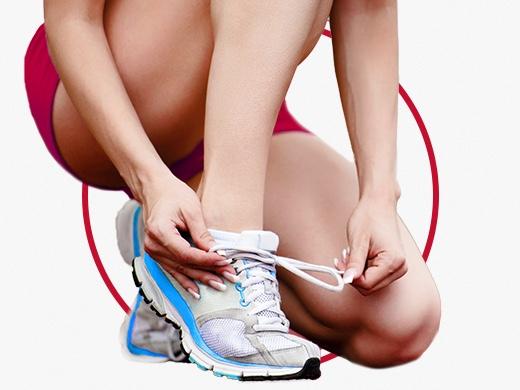When drying your feet, pay special attention to areas between your toes.
Athlete's foot
You don’t have to be an athlete to catch it - athlete’s foot can affect anyone!
Athlete’s foot (tinea pedis) is a fungal skin infection of the feet caused, primarily, by fungi called dermatophytes. They thrive in warm and moist environments, such as changing rooms and showers, shoes and socks or sweaty feet. That's why they feel right at home between your toes but can also affect the soles and sides of your feet.

Athlete’s foot symptoms
You might be suffering from athlete’s foot if you experience:
- Itchy and burning toes and feet
- Scaly, very dry, cracked or peeling skin
- Splitting, softening or whitening skin between toes
- Cracking skin between the toes, on the soles or heels
- Smelly feet
You can also experience more severe symptoms:
- Vesicles on the skin
- Inflammation of cracked skin

Understanding athlete's foot
The most important thing you need to know about athlete’s foot is that it’s very contagious. You can easily catch the infection through skin-to-skin contact or through contact with contaminated surfaces. Also, if left untreated it is much more likely to return, and the fungus can spread to other areas of your body or to your loved ones.

Athlete's foot treatment
An effective antifungal medication is the best treatment for your condition. Athlete's foot treatments are available over the counter from your pharmacy, in your supermarket or online.
Topical treatments are easy to apply and target the main types of fungi that cause athlete's foot. Sometimes, it is important to use concomitantly mild corticosteroid that treats symptoms of inflamed athlete's foot (e.g. hydrocortisone). Canesten offers a range of complete antifungal treatments that stop fungal growth, kill the fungi and relieve the symptoms of athlete’s foot.
Discover Canesten products
Preventing athlete's foot
Wear clean socks every day. Change them after playing sports or on hot days.
Keep your toenails trimmed and clean to prevent spreading the fungal infection.
Facts about athlete's foot
You may be more at risk of catching athlete’s foot when walking barefoot in public showers, gyms and changing rooms or when in contact with an infected person.
It’s a common problem: over 70% of the population will experience athlete’s foot during their lifetime1. While anyone can catch the infection, men and older people are more at risk.
Treat it early - when left untreated, athlete's foot can spread to other parts of your body. This often occurs through scratching and can cause other fungal infections like jock itch.
References:
1. Brooks KE et al. Clin Podiatr Med Surg 1996.
Frequently Asked Questions:
How do I treat athlete’s foot?
Athlete’s foot is a very common skin infection caused by fungus, and you can treat it easily with an anti-fungal medicine applied directly onto the infected area. There are several Canesten products available to treat your athlete’s foot.
If I ignore it, will it go away on its own?
Unfortunately not. Athlete’s foot is a fungal skin infection which requires treatment with anti-fungal medicine. The earlier you treat it the sooner it will clear up. For information on treating athlete’s foot simply and effectively, visit our athlete’s foot treatment page.
How long does the treatment take?
Depending on the product, recommended treatment time varies. The symptoms of the skin infection, such as itching or soreness, should improve within a few days of treatment with all Canesten Athlete’s foot creams. You will need to continue treatment for 2 weeks after symptoms disappear, to avoid recurrence. If the symptoms do not improve within 7 days, please consult your doctor.
Can I continue exercising if I have athlete’s foot?
Athlete’s foot shouldn’t stop you from exercising, though you should stay away from swimming in order to help prevent spreading the infection. When exercising, you should wear cotton socks and in changing rooms you should wear flip flops or sandals. After exercising, be sure to properly clean and dry your feet, wash your socks in hot water and let your shoes dry after wearing them.
How do I prevent athlete’s foot in future?
There are a few simple steps you can take to lower your risk of getting athlete’s foot. The most important measure you can take is to keep your feet clean and dry, especially after spending time in public changing rooms, pools or showers. You can also try using Tinaderm Powder Spray, which can help to prevent reinfection if regularly sprayed on the feet, shoes and/or socks.
Can Athlete's Foot affect my toenails?
If left untreated, athlete's foot can spread into your nail. This can cause a fungal nail infection, resulting in your nail becoming discoloured and thick and start to deteriorate and crumble.
Can only Athletes Get Athletes Foot?
You don’t need to be an athlete to get this infection. Athlete’s foot got its name because the fungus that causes it likes to hang out in places athlete frequent, like showers, swimming pools and locker rooms. Anyone who gets exposed to the fungus can get infected included women.
Can I catch athlete's foot by sharing a towel with someone who has it?
Yes, Tinea (Athlete's Foot) can be spread by skin to skin contact or indirectly through towels, clothes or floors.
Learn more about skin & foot health

Learn all about athlete’s foot
Learn about what athlete’s foot is and how you can catch it. Find out about the symptoms of this fungal infection and how you can treat it. Discover tips on preventing athlete’s foot.

Everything to know about jock itch
Find out what is jock itch and what can cause it. Learn about jock itch treatment, symptoms and prevention.

Understanding fungal nail infection
Fight the thick discolored and brittle toenails caused by nail fungus and discover Canesten Fungal Nail Treatment Set.

Facts about ringworm
Find out what ringworm is, what causes it, how is ringworm spread and who can get it. Learn about common ringworm symptoms, ringworm treatment and prevention.

Find out more about sweat rash
Find out what sweat rash is, what causes it and who is at risk of getting it. Learn about sweat rash symptoms, treatment and prevention.

Practical tips for skin and foot hygiene
Find out how good hygiene practices can help you avoid catching and spreading fungal infections.



